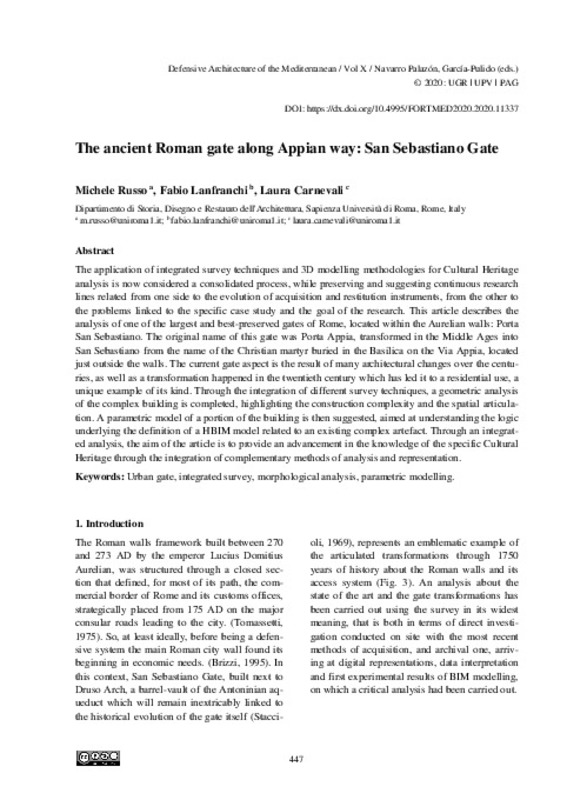JavaScript is disabled for your browser. Some features of this site may not work without it.
Buscar en RiuNet
Listar
Mi cuenta
Estadísticas
Ayuda RiuNet
Admin. UPV
The ancient Roman gate along Appian way: San Sebastiano Gate
Mostrar el registro sencillo del ítem
Ficheros en el ítem
| dc.contributor.author | Russo, Michele
|
es_ES |
| dc.contributor.author | Lanfranchi, Fabio
|
es_ES |
| dc.contributor.author | Carnevali, Laura
|
es_ES |
| dc.coverage.spatial | east=12.5014081; north=41.8734634; name=Via di Porta San Sebastiano, 18, 00179 Roma RM, Itàlia | es_ES |
| dc.date.accessioned | 2020-07-03T09:24:22Z | |
| dc.date.available | 2020-07-03T09:24:22Z | |
| dc.date.issued | 2020-05-15 | |
| dc.identifier.isbn | 9788490488560 | |
| dc.identifier.uri | http://hdl.handle.net/10251/147363 | |
| dc.description.abstract | [EN] The application of integrated survey techniques and 3D modelling methodologies for Cultural Heritage analysis is now considered a consolidated process, while preserving and suggesting continuous research lines related from one side to the evolution of acquisition and restitution instruments, from the other to the problems linked to the specific case study and the goal of the research. This article describes the analysis of one of the largest and best-preserved gates of Rome, located within the Aurelian walls: Porta San Sebastiano. The original name of this gate was Porta Appia, transformed in the Middle Ages into San Sebastiano from the name of the Christian martyr buried in the Basilica on the Via Appia, located just outside the walls. The current gate aspect is the result of many architectural changes over the centuries, as well as a transformation happened in the twentieth century which has led it to a residential use, a unique example of its kind. Through the integration of different survey techniques, a geometric analysis of the complex building is completed, highlighting the construction complexity and the spatial articulation. A parametric model of a portion of the building is then suggested, aimed at understanding the logic underlying the definition of a HBIM model related to an existing complex artefact. Through an integrated analysis, the aim of the article is to provide an advancement in the knowledge of the specific Cultural Heritage through the integration of complementary methods of analysis and representation. | es_ES |
| dc.language | Inglés | es_ES |
| dc.publisher | Editorial Universitat Politècnica de València | es_ES |
| dc.rights | Reconocimiento - No comercial - Sin obra derivada (by-nc-nd) | es_ES |
| dc.subject | Fortifications | es_ES |
| dc.subject | Mediterranean | es_ES |
| dc.subject | Modern age | es_ES |
| dc.subject | Built Heritage | es_ES |
| dc.subject | Urban Gate | es_ES |
| dc.subject | Integrated Survey | es_ES |
| dc.subject | Morphological Analysis | es_ES |
| dc.subject | Parametric modelling | es_ES |
| dc.title | The ancient Roman gate along Appian way: San Sebastiano Gate | es_ES |
| dc.type | Capítulo de libro | es_ES |
| dc.type | Comunicación en congreso | es_ES |
| dc.identifier.doi | 10.4995/FORTMED2020.2020.11337 | |
| dc.rights.accessRights | Abierto | es_ES |
| dc.description.bibliographicCitation | Russo, M.; Lanfranchi, F.; Carnevali, L. (2020). The ancient Roman gate along Appian way: San Sebastiano Gate. Editorial Universitat Politècnica de València. 447-454. https://doi.org/10.4995/FORTMED2020.2020.11337 | es_ES |
| dc.description.accrualMethod | OCS | es_ES |
| dc.relation.conferencename | FORTMED2020 - Defensive Architecture of the Mediterranean | es_ES |
| dc.relation.conferencedate | Octubre 01-03,2020 | es_ES |
| dc.relation.conferenceplace | Granada, Spain | es_ES |
| dc.relation.publisherversion | http://ocs.editorial.upv.es/index.php/FORTMED/FORTMED2020/paper/view/11337 | es_ES |
| dc.description.upvformatpinicio | 447 | es_ES |
| dc.description.upvformatpfin | 454 | es_ES |
| dc.type.version | info:eu-repo/semantics/publishedVersion | es_ES |
| dc.relation.pasarela | OCS\11337 | es_ES |








